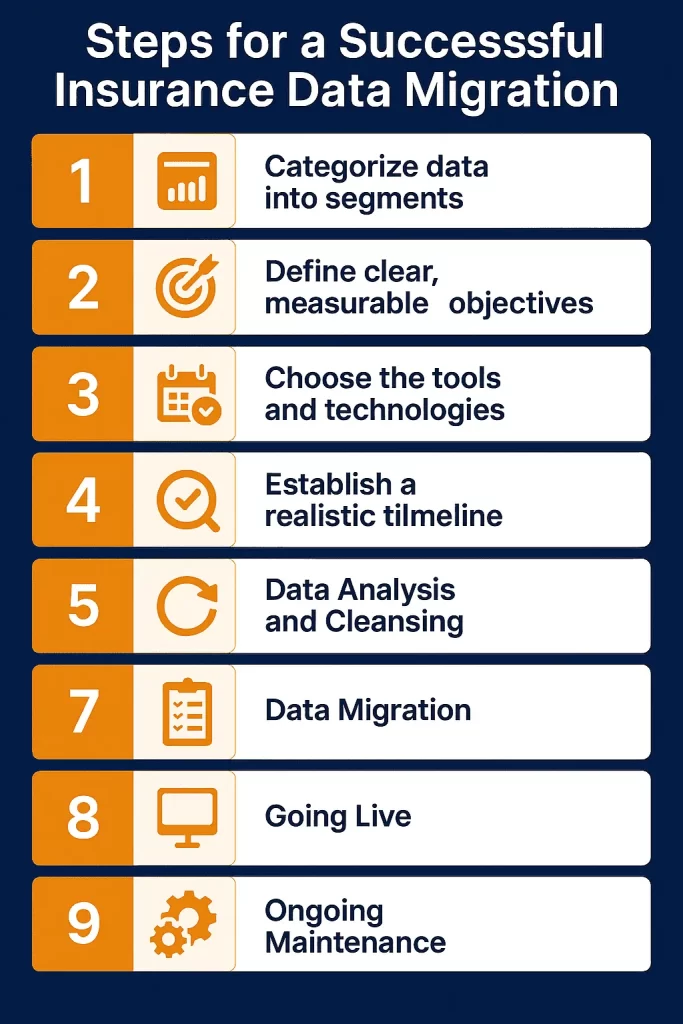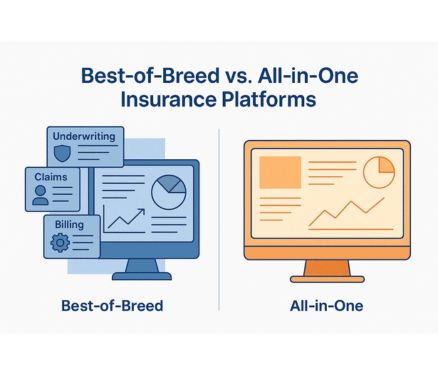How to Migrate Your Insurance Policy Data Smoothly?
In an industry shaped by evolving consumer expectations, mounting regulatory pressure, and a surge in Insurtech innovation, the ability to seamlessly migrate legacy policy data is not just an IT exercise – it’s a strategic imperative. For insurers, reinsurers, and carriers alike, legacy systems often hold decades of critical policy, claims, and customer information. But to remain competitive and compliant, this data must be liberated, cleansed, and restructured within modern ecosystems.
Policy data migration, when executed with precision, becomes a cornerstone of operational agility, risk mitigation, and scalable growth. When poorly handled, however, it can lead to costly business interruptions, audit failures, or even reputational harm. Let’s explore the key considerations, challenges, and success factors in navigating this transformation.
Why Do Insurance Companies Need to Migrate Data?
Most insurance enterprises today are navigating transformations that demand robust data portability. Common catalysts include
- Core System Modernization: Ageing policy administration systems (PAS) lack the flexibility and integration capabilities required by today’s digital platforms.
- Mergers & Acquisitions: Consolidating data across acquired entities requires unification across multiple systems and standards.
- Regulatory Evolution: U.S. regulators increasingly expect real-time data availability, audit transparency, and robust lineage tracking.
- Cloud Adoption: To meet scalability and cost-efficiency demands, more carriers are moving their data operations to the cloud.
- Operational Streamlining: Automating underwriting, claims, and reporting depends on data that’s accurate, accessible, and aligned across platforms.
In short, migrating policy data is about future-proofing insurance operations while eliminating technical debt.
5 Core Challenges in Insurance Data Migration
Data migration in insurance is more nuanced than in most industries due to the depth, sensitivity, and interdependencies involved. The key obstacles include:
- Data Volume and Legacy Systems
Mainframe PAS often holds structured and semi-structured data, intertwined with business logic coded decades ago. Extracting this data without disrupting business logic introduces significant complexity. - Data Accuracy and Quality
Legacy data is riddled with anomalies: duplicate policy records, missing beneficiary information, misclassified endorsements, etc. It takes a balance to clean this while maintaining integrity. - Security Concerns
Policy data includes sensitive PII, payment methods, and historical claims—requiring end-to-end encryption, masking, and stringent access controls. - Regulatory Compliance
Compliance with frameworks like HIPAA, NAIC Model Laws, and state-specific DOI rules demands full traceability of every migrated record. - Disruptions to Daily Operation
Downtime during migration can hinder new policy issuance, premium collection, or claims processing, impacting both profitability and customer experience.
9 Steps for a Successful Insurance Data Migration
To navigate this complexity, a phased, consultative approach must be employed. Below are the key steps for a seamless migration:

1. Categorize Data into Segments
Begin by identifying critical business domains such as policyholder data, underwriting rules, billing cycles, claims history, and compliance artifacts. Establishing relationships and hierarchies ensures accurate transformation and integration into the target system.
2. Define Clear, Measurable Objectives
Set strategic goals that align with your enterprise roadmap, whether it’s reducing operational costs, enabling automation, or enhancing regulatory readiness. KPIs like data accuracy percentage, downtime reduction, or SLA improvement help track success.
3. Choose the Right Tools and Technologies
Select technologies that can handle complex insurance-specific data models with precision. ETL (Extract, Transform, Load) tools, data quality engines, and governance platforms, which enable structured migration while reducing error rates and ensuring traceability.
4. Establish a Realistic Timeline
Design a phased rollout schedule that accommodates business-critical processes. Include buffer periods for parallel runs, validations, and stakeholder feedback to mitigate risks associated with tight deadlines.
With Practo Insura’s data migration feature, you can resume where you left off without having to wait six months on the previous system. You can quickly switch systems if your policy dataset is well-structured, preventing any disruptions to your business operations.
5. Data Analysis and Cleansing
Use profiling tools to assess the completeness, consistency, and accuracy of existing data. Cleansing involves standardizing formats, removing duplicates, and flagging invalid entries, laying the foundation for reliable downstream processes.
6. Execute Data Migration
Implement a repeatable, auditable migration process that includes data extraction, transformation (ETL), database schema mapping, and secure loading. This phase must align with business continuity plans to prevent operational disruptions.
7. Testing & Validation
Validate both the data and the workflows it supports. Use system integration testing to ensure technical correctness, user acceptance testing to confirm functional requirements, and reconciliation reports to compare source and target data volumes, formats, and business rules.
8. Go Live
Opt for a controlled go-live using a phased or parallel approach, especially for high-risk domains like claims or billing. Ensure rollback plans, support teams, and performance monitoring are in place to manage any post-migration issues.
9. Ongoing Maintenance
Data migration doesn’t end at deployment. Establish monitoring dashboards, perform periodic audits, and implement anomaly detection to maintain data integrity and system performance. This ensures long-term value and compliance.
6 Pillars of Data Migration: Types Explained
Understanding the scope and nature of your migration helps define the appropriate strategies. Common migration types include:
- Database Migration: This involves transferring structured data from legacy systems like DB2 or Oracle to modern, cloud-native platforms such as PostgreSQL or Snowflake enabling better scalability
- Application Migration: Policy data and associated logic are moved from outdated or custom PAS solutions to modern platforms to help insurers modernize workflows and integrate with digital ecosystems.
- Cloud Migration: Core data infrastructure is transitioned from on-premises servers to cloud environments, enhancing system elasticity, availability, and disaster recovery capabilities.
- Data Centre Migration: Physical-to-virtual migrations or location transfers to reduce overhead and improve disaster recovery.
- Business Process Migration: Reengineering underwriting, claims, or actuarial workflows during the platform changeover.
- Storage Migration: Involves shifting archival data, often stored on legacy tapes or physical drives, to cloud object storage, improving accessibility and indexing.
5 Benefits of Insurance Data Migration
When executed effectively, data migration delivers immediate and long-term advantages:
- Reduced Operational Costs: Maintaining legacy systems can consume a significant portion of IT budgets. For instance, organizations typically spend 70–80% of their IT budgets on maintaining existing systems, with legacy systems consuming a disproportionate share of these resources
- Improved Efficiency: Streamlined data access boosts team productivity, particularly in underwriting and claims. Insurers can expect up to a 40% productivity increase after transforming their legacy systems
- Enhanced Productivity: Studies have shown that data migration significantly reduces processing times, with modern systems improving operational efficiency by streamlining workflows, minimizing bottlenecks, and automating repetitive tasks.
- Better Data Security: Businesses can improve data protection and compliance by implementing efficient security measures like end-to-end encryption and AI-powered monitoring by modernizing their data systems.
- Better Decision-Making: Real-time reporting and advanced analytics are made possible by clean, centralized data. Modern digital insurance systems have built-in AI-driven risk analytics and anomaly detection, helping insurers prevent fraud and minimize losses
Final Thoughts: Beyond the Move
Insurance data migration isn’t a one-time thing, it’s the beginning of a broader modernization journey. By taking a structured approach rooted in data governance, operational alignment, and technological rigour, insurers can not only move their data but also transform it into a strategic enabler.
Platforms like Practo Insura have emerged to support insurers, reinsurers, and carriers through this transition, offering tailored tools that blend compliance, speed, and security in a single migration ecosystem.
We specialize in developing innovative Property & Casualty (P&C) insurance software solutions, leveraging over 8 years of InsurTech expertise to simplify insurance operations and enhance efficiency.


